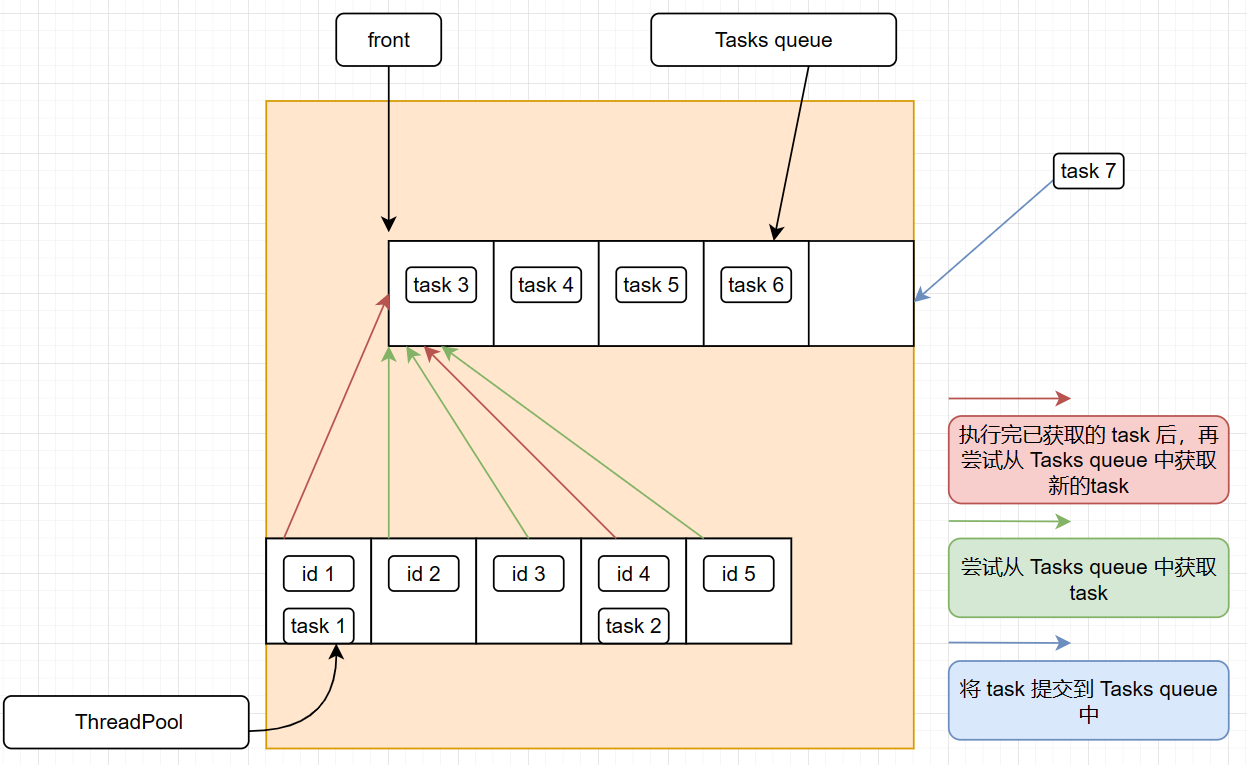基于生产者-消费者模型的线程池。
整体设计

线程池由两部分组成 存放线程的容器(ThreadPool) 和 一个任务队列(Tasks queue)。
容器中的线程都做相同的事情:
这些线程会一直重复这两个动作。
例如, 图中 id 为 1,4 的线程已经获得了一个任务,接下来它们要执行这个任务, 然后继续从任务队列中获取任务…
id 为 2, 3, 5 的线程正在从任务队列获得一个任务…
- 会有多个线程访问任务队列,因此任务队列必须要支持并发。
- 每个线程会一直运行直到线程池关闭,从任务队列获取一个任务,执行,不断重复这个过程,如果不能获取一个任务(任务队列中可能没有任务了),就要阻塞在获取任务这一步,直到获取了任务或线程池关闭。
支持并发的队列
1
2
3
4
5
6
7
8
9
10
| template <typename T> class SafeQueue {
private:
std::queue<T> que_;
std::shared_mutex mutex_;
public:
void push(T &t);
T pop();
size_t size();
};
|
使用读写锁对 std::queue 做了封装。
push
1
2
3
4
5
| template<typename T>
void SafeQueue<T>::push(T &t) {
std::unique_lock lock(mutex_);
que_.emplace(t);
}
|
pop
1
2
3
4
5
6
7
| template<typename T>
T SafeQueue<T>::pop() {
std::unique_lock lock(mutex_);
T ret = que_.front();
que_.pop();
return ret;
}
|
size
1
2
3
4
5
| template<typename T>
size_t SafeQueue<T>::size() {
std::shared_lock lock(mutex_);
return que_.size();
}
|
线程容器
线程从任务队列获取任务后执行的过程的模型是生产者-消费者。
因此需要一个条件变量 std::condition_variable。
1
2
3
4
5
6
7
8
9
10
11
12
13
14
15
16
17
18
19
20
21
22
23
24
25
26
27
28
29
30
31
32
33
| class ThreadPool {
private:
class ThreadWorker {
private:
ThreadPool *pool_;
size_t thread_id_;
public:
ThreadWorker(ThreadPool *pool, size_t thread_id_)
: pool_(pool), thread_id_(thread_id_) {}
void operator()();
};
size_t threads_;
bool shutdown_;
SafeQueue<std::function<void()>> tasks_;
std::vector<std::thread> works_;
std::condition_variable condition_;
std::mutex mutex_;
public:
ThreadPool(size_t threads = 2) { init(threads); };
ThreadPool(const ThreadPool &other) = delete;
ThreadPool(ThreadPool &&other) = delete;
ThreadPool &operator=(const ThreadPool &other) = delete;
ThreadPool &operator=(ThreadPool &&other) = delete;
~ThreadPool() { shutdown(); };
void init(size_t threads);
void shutdown();
template <typename F, typename... Arg>
auto submit(F &&f, Arg &&...args) -> std::future<decltype(f(args...))>;
};
|
初始化
在构造函数中调用了 init 来提升易用性。
初始化时就把需要使用到的线程数量都启动起来。
1
2
3
4
5
6
7
8
9
10
11
12
13
14
15
16
17
18
19
20
21
22
23
24
25
26
27
28
29
30
31
32
| void ThreadPool::init(size_t threads) {
threads_ = threads;
shutdown_ = false;
while (tasks_.size() != 0) {
tasks_.pop();
}
{
std::vector<std::thread> tmp_works{};
works_.swap(tmp_works);
}
works_.reserve(threads_);
works_.resize(threads_);
for (size_t i = 0; i < threads_; ++i) {
works_[i] = std::thread([this] {
std::function<void()> func;
for (;;) {
{
std::unique_lock lock(mutex_);
condition_.wait(lock, [this] {
return shutdown_ || tasks_.size() > 0;
});
if (shutdown_ && tasks_.size() == 0) {
return;
}
func = std::move(tasks_.pop());
}
func();
}
});
}
}
|
关闭线程池
关闭线程池时,要等待线程做完事(队列中的任务被全部完成, 在 ThreadWorker 中作判断)。
在析构函数中调用了 shutdown() , 利用 RAII 来实现自动关闭。
1
2
3
4
5
6
7
8
9
10
11
12
13
| void ThreadPool::shutdown() {
if (shutdown_) {
return;
}
shutdown_ = true;
condition_.notify_all();
for (size_t i = 0; i < threads_; ++i) {
if (works_[i].joinable()) {
works_[i].join();
}
}
threads_ = 0;
}
|
提交任务
任务是一个函数,可以是任意的返回类型,任意的参数。
使用可变参数模板来实现,支持函数,仿函数,Lambda, 以及任意多的参数。
有的任务在被执行过后会有返回值,需要使用 std::future<> 来获得这个值, 任务的返回值类型是多种多样的,所以使用 decltype() 来推导返回值的类型。
任务的多样性,没有办法直接确定一个类型来表示它们,对任务进行封装,使所有的任务都是 void() 类型。
任务进入队列后,要唤醒一个线程(告诉在阻塞的线程,队列中有了新的任务)。
1
2
3
4
5
6
7
8
9
10
11
12
13
14
15
16
17
| template <typename F, typename... Arg>
auto ThreadPool::submit(F &&f, Arg &&...args) -> std::future<decltype(f(args...))> {
std::function<decltype(f(args...))()> func =
std::bind(std::forward<F>(f), std::forward<Arg>(args)...);
auto task_ptr =
std::make_shared<std::packaged_task<decltype(f(args...))()>>(func);
std::function<void()> wrap_task = [task_ptr] { (*task_ptr)(); };
tasks_.push(wrap_task);
condition_.notify_one();
return task_ptr->get_future();
}
|
参考
C++ 并发编程 (从C++11到C++17)
C++的右值引用、移动和值类别系统,你所需要的一切
基于C++11实现的线程池
99行线程池
